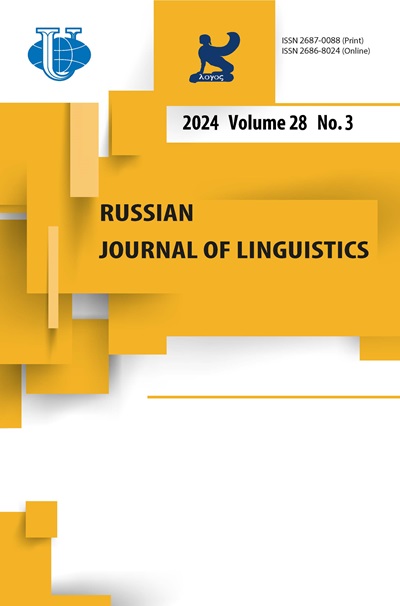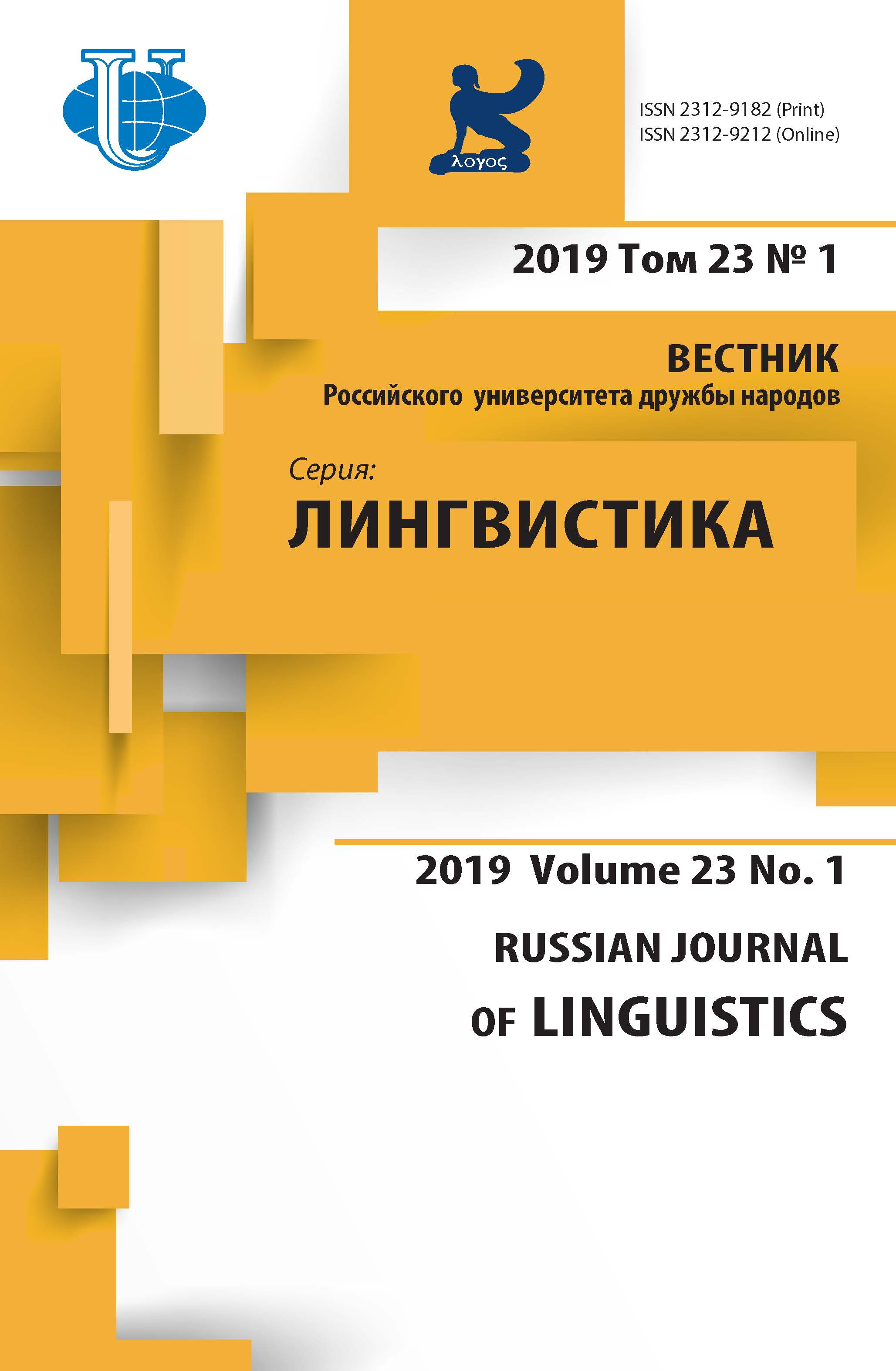Творческая интерпретация метафор
- Авторы: Музолф А.1
-
Учреждения:
- Университет Восточной Англии
- Выпуск: Том 23, № 1 (2019)
- Страницы: 23-39
- Раздел: СОЦИОЛИНГВИСТИКА
- URL: https://journals.rudn.ru/linguistics/article/view/20614
- DOI: https://doi.org/10.22363/2312-9182-2019-23-1-23-39
Цитировать
Полный текст
Аннотация
В статье рассматривается инновационное творческое осмысление метафор, меняющее значение устойчивых образных выражений. В частности анализируются интерпретационные изменения в семантике телесных метафор. В качестве материала выступают корпус британского политического дискурса и результаты опроса более 1000 респондентов из 10 стран, говорящих на 31 языке. Корпусные данные показывают, каким образом ситуативные вариации в использовании метафор могут со временем формировать семантико-прагматические тенденции, меняющие доминантное значение устойчивых метафорических выражений. Опрос позволяет выделить четыре модели прочтения телесных метафор (нация как геоструктура, иерархически функционирующее целое, часть тела говорящего, часть более крупного целого), а также их последующие антропоцентричные осмысления. Две наиболее распространенные интерпретации - нация как геоструктура и иерархически функционирующее целое, а также варианты стереотипизации личности, демонстрируют несовпадение частотности и толкования соответствующих единиц респондентами - носителями китайского и английского языков, что может быть связано с культурно-специфическими концептуальными и дискурсивными традициями. Оба вида данных указывают на наличие мощной творческой составляющей в интерпретации метафор, что объясняет вариативность при создании новых метафорических понятий.
Ключевые слова
Об авторах
Андреас Музолф
Университет Восточной Англии
Email: A.Musolff@uea.ac.uk
профессор, преподает межкультурную коммуникацию в Университете Восточной Англии в Норвиче (Великобритания). Norwich Research Park, NR4 7TJ, Норвич, Великобритания
Список литературы
- Barnden, J. A. 2009. Metaphor and Context: A Perspective from Artificial Intelligence. In A. Musolff and J. Zinken (Eds.), Metaphor and Discourse (79-94). Basingstoke: Palgrave-Macmillan.
- Bickers, R.. 2012. The Scramble for China. Foreign Devils in the Qing Empire. 1832-1914. London: Penguin.
- Bowdle, B. F. & Gentner, D. (2005). The career of metaphor. Psychological Review, 112(1), 193-216.
- Brewer’s Dictionary of Phrase & Fable, 1999. Ed. A. Room. London: Cassell.
- Callahan, W. A. (2009). The cartography of national humiliation and the emergence of China’s geobody. Public Culture 21(1), 141-173.
- Callahan, W. A. (2010). China - The Pessoptimist Nation. Oxford: Oxford University Press.
- Charbonnel, N. (2010). Comme un seul home. Corps politique et corps mystique. 2 vols. Lons Le Saunier: Aréopage.
- Clayton, C. H. (2009). Sovereignty at the Edge: Macau & the Question of Chineseness. Cambridge, MA: Harvard University Press.
- Chilton, P., & Lakoff, G. (1995). Foreign Policy by Metaphor. In C. Schäffner & A. Wenden (Eds.). Language and Peace (pp. 37-55). Aldershot: Ashgate.
- Connolly, B. (1995). The Rotten Heart of Europe. London: Faber.
- Croft, W. and Cruse, D.A. (2004). Cognitive Linguistics. Cambridge: Cambridge University Press.
- Culpeper, J. (2011). Impoliteness: Using Language to Cause Offence. Cambridge: Cambridge University Press.
- de Baecque, A. (1997). The Body Politic. Corporeal Metaphor in Revolutionary France 1770-1800. Stanford, CA: Stanford University Press.
- Fauconnier, G. & Turner, M. (2002). The Way we Think: Conceptual Blending and the Mind’s Hidden Complexities. New York: Basic Books.
- Giora, R. (2003). On our Mind: Salience, context, and figurative language. New York: Oxford University Press.
- Goatly, A. (1997). The Language of Metaphors. London: Routledge.
- Guldin, R. (2000). Körpermetaphern: Zum Verhältnis von Politik und Medizin. Würzburg: Königshausen & Neumann.
- Hansard (1991). House of Commons Debate on the European Council in Maastricht 11 December 1991 (Hansard vol. 200, cc. 859-78). http://hansard.millbanksystems.com/commons/1991/dec/ 11/european-council-maastricht (accessed 22 September 2017).
- Idström, A. & Piirainen, E. (Eds.) (2012). Endangered Metaphors. In cooperation with Falzett, T.F.M. Amsterdam: John Benjamins.
- Kantorowicz, E. H. (1997). The King’s Two Bodies: A Study in Mediaeval Political Theology. With a new Preface by W. C. Jordan. Princeton, NJ: Princeton University Press.
- Kövecses, Z. (2002). Metaphor. A Practical Introduction. Oxford/New York: Oxford University Press.
- Kövecses, Z. (2005). Metaphor in Culture: Universality and Variation. Cambridge: Cambridge University Press.
- Kövecses, Z. (2006). Language, Mind and Culture. A Practical Introduction. Oxford / New York: Oxford University Press.
- Kövecses, Z. (2009). Metaphor, Culture, and Discourse: The Pressures of Coherence. In: A. Musolff & J. Zinken (Eds.). Metaphor and Discourse (pp. 11-24). Basingstoke: Palgrave-Macmillan.
- Lakoff, G. (1987). The Death of Dead Metaphor. Metaphor & Symbolic Activity, 2(2), 143-147.
- Lakoff, G. (1993). The contemporary theory of metaphor. In A. Ortony (Ed.). Metaphor and Thought (pp. 202-251). Cambridge: Cambridge University Press.
- Lakoff, G. (1996). Moral Politics: What Conservatives Know That Liberals Don’t. Chicago: University of Chicago Press.
- Lakoff, G. (2003). Metaphor and War, Again. http://www.alternet.org/story.html?StoryID=15414 (accessed 21/09/2017).
- Lakoff, G. (2004). Don’t Think of an Elephant! Know Your Values and Frame the Debate. The essential guide for progressives. White River Junction, VT: Chelsea Green Publishing Company.
- Lakoff, G. (2008). The neural theory of metaphor. In: R. W. Gibbs (ed.). The Cambridge Handbook of Metaphor and Thought (pp. 17-38) Cambridge: Cambridge University Press.
- Lakoff, G. (2013). Obama Reframes Syria: Metaphor and War Revisited. The Huffington Post, 6 September 2013. http://georgelakoff.com/2013/09/06/obama-reframes-syria-metaphor-and-war-revisited/ (accessed 21/09/2017).
- Lakoff, G. & M. Johnson (1980/2003). Metaphors we live by. Chicago: University of Chicago Press.
- Lakoff, G. & M. Johnson (1999). Philosophy in the Flesh. New York: Basic Books.
- Lakoff, G. & Turner, M. (1989). More than Cool Reason. A Field Guide to Poetic Metaphor. Chicago: University of Chicago Press.
- Littlemore, J. (2001). The use of Metaphor in University Lectures and the problems that it causes for overseas students. Teaching in Higher Education 6, 331-349.
- Littlemore, J. (2003). The Effect of Cultural Background on Metaphor Interpretation. Metaphor and Symbol, 18(4), 273-288.
- Littlemore, J., Chen, P. Koester, A. & Barnden, J. (2011). Difficulties in metaphor comprehension faced by international students whose first language is not English. Applied Linguistics, 32(4), 408-429.
- Lovejoy, A. O. (1936). The Great Chain of Being. Cambridge, MA: Harvard University Press.
- Major, J. (2000). The Autobiography. London: HarperCollins.
- Müller, C. (2008). Metaphors Dead and Alive, Sleeping and Waking: A Dynamic View. Chicago, IL: University of Chicago Press.
- Musolff, A. (2004a). Metaphor and Political Discourse. Analogical Reasoning in Debates about Europe. Basingstoke: Palgrave-Macmillan.
- Musolff, A. (2004b). The Heart of the European Body Politic. British and German Perspectives on Europe’s Central Organ. Journal of Multilingual & Multicultural Development, 25 (5 & 6), 437-452.
- Musolff, A. (2006). Metaphor Scenarios in Public Discourse. Metaphor and Symbol, 21(1), 23-38.
- Musolff, A. (2010). Metaphor, Nation and the Holocaust. The Concept of the Body Politic. London: Routledge.
- Musolff, A. (2013). The heart of Europe: Synchronic variation and historical trajectories of a Political Metaphor. In Fløttum, K. (Ed.), Speaking of Europe: Approaches to complexity in European political discourse (pp. 135-150). Amsterdam: John Benjamins.
- Musolff, A. (2016). Cross-Cultural Variation in Deliberate Metaphor Interpretation. Metaphor and the Social World 6(2): 205-224.
- Musolff, A. (2017a). Metaphor, irony and sarcasm in public discourse. Journal of Pragmatics, 109, 95-104.
- Musolff, A. (2017b). Metaphor and Cultural Cognition’. In Sharifian, F. (ed.). Advances in Cultural Linguistics (pp. 325-344). Singapore: Springer.
- Musolff, A., MacArthur, F. & Pagani, G. (Eds.). (2014). Metaphor and Intercultural Communication. London: Bloomsbury.
- Nacey, S. (2013). Metaphors in Learner English. Amsterdam: John Benjamins.
- Piquer-Píriz, A. (2010). Can people be cold and warm? Developing understanding of figurative meanings of temperature terms in early EFL. In G. Low, Z. Todd, A. Deignan, & L. Cameron (Eds.), Researching and Applying Metaphor in the Real World (pp. 21-34). Amsterdam: John Benjamins
- Philip, G. (2010). “Drugs, traffic, and many other dirty interests”: Metaphor and the language learner. In G. Low, Z. Todd, A. Deignan and L. Cameron (Eds.), Researching and Applying Metaphor in the Real World (pp. 63-80). Amsterdam: John Benjamins. Roget’s International Thesaurus, 1996. Ed. Chapman, R. Glasgow: HarperCollins
- Shorter Oxford English Dictionary (2002). Eds. Trumble, W. R. & Stevenson, A. Oxford: Oxford University Press.
- Schneider, F. (2014). It’s a small world after all? Simulating the future world order at the Shanghai Expo. In Q. Cao, H. Tian & P. Chilton (eds.), Discourse, Politics and Media in Contemporary China (pp. 97-120). Amsterdam: John Benjamins.
- Schneider, F. & Hwang, Y-J. (2014). China’s Road to Revival. “Writing” the PRC’s struggles for modernization. In Q. Cao, H. Tian & P. Chilton (eds.), Discourse, Politics and Media in Contemporary China (pp. 145-170). Amsterdam: John Benjamins.
- Sontag, S. (1978). Illness as Metaphor. New York: Vintage Books.
- Sperber, D. (Ed.) (2000). Metaprepresentations: a multidisciplinary perspective. Oxford: Oxford University Press.
- Sperber, D. & Wilson, D. (1995). Relevance. Communication and Cognition. Oxford: Blackwell.
- Steen, G. (2008). The paradox of metaphor: Why we need a three-dimensional model of metaphor. Metaphor and Symbol 23 (4), 213-241.
- Steen, G. (2011). What does ‘really deliberate’ really mean? More thoughts on metaphor and consciousness and action. Metaphor and the Social World 1 (1), 53-56.
- Tendahl, M. & Gibbs, R. W. (2008). Complementary perspectives on metaphor: Cognitive linguistic and relevance theory. Journal of Pragmatics 40(l), 1823-1864.
- Trim, R. (2011). Metaphor and the Historical Evolution of Conceptual Mapping. Basingstoke: Palgrave Macmillan.
- Trim R. (2012). The limits of Comprehension in Cross-Cultural Metaphor: Networking in Drugs Terminology. In F. MacArthur, J. L. Oncins-Martínez, M. Sánchez-García, & A. M. Piquer-Píriz (Eds.), Metaphor in Use: Context, culture, and communication (pp. 217-238). Amsterdam: John Benjamins
- Weinreich, H. (1983). Die Semantik der kühnen Metapher. In A. Haverkamp (Ed.). Theorie der Metapher (pp. 316-339). Darmstadt: Wissenschaftliche Buchgesellschaft
- Wilson, D. & Sperber, D. (1992). On verbal irony. Lingua 87, 53-76
- Wilson, D. & Sperber, D. (2012). Explaining irony. In D. Wilson & D. Sperber (Eds.). Meaning and Relevance (pp. 123-145). Cambridge: Cambridge University Press

















